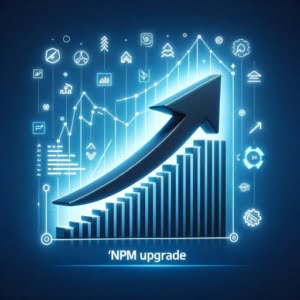Upgrading Packages with npm | Node.js Dependency Guide

While managing Node.js projects on IOFlood servers, I found myself needing a consistent way to update packages. This led me to explore the npm upgrade command, which offers a straightforward solution for upgrading packages in Node.js projects. To help other developers, I have put all my insights into this comorehensive guide. By mastering npm upgrade, we can ensure our projects stay up-to-date with the latest features and security patches, enhancing their reliability and performance.
This article will walk you through the basics to more advanced techniques of using npm upgrade. We aim to ensure your Node.js projects remain secure, efficient, and on the cutting edge of technology advancements. From understanding the impact of outdated dependencies to mastering the command line for updates, we’ve got you covered.
Let’s streamline our package management process by mastering npm upgrade!
TL;DR: How Do I Upgrade Packages Using npm?
To upgrade packages using npm, utilize the
npm upgradecommand to update all or specific packages in your project. This command respects the version ranges specified in yourpackage.jsonfile, ensuring a smooth update process.
Here’s a quick example:
npm upgrade --depth=2
# Output:
# audited 100 packages in 2.582s
# found 0 vulnerabilities
In this example, the –depth=2 flag limits the depth of the dependency tree that npm will traverse when upgrading packages. The terminal output confirms that 100 packages were audited and no vulnerabilities were found during the upgrade process.
Dive deeper into this article for more detailed instructions, advanced options, and troubleshooting tips to master the npm upgrade process.
Table of Contents
Beginner’s Guide to npm Upgrade
When you’re just starting out with Node.js, understanding how to keep your project’s dependencies up to date is crucial. npm upgrade is a powerful command that simplifies this process. Let’s dive into the basics, including how to upgrade all packages, target specific ones, and comprehend the impact on your package.json and package-lock.json files.
Upgrading All Packages
To upgrade all packages in your project to their latest versions within the versions specified in your package.json, simply run:
npm upgrade
# Expected Output:
# + package-name@version
# updated 1 package in 5.342s
This command will update all your project’s dependencies to the latest versions that still satisfy the version ranges defined in your package.json. It’s crucial to note that while this method is straightforward and automates the update process, it may introduce breaking changes if the version ranges in your package.json are not set cautiously.
Targeting a Specific Package
If you wish to upgrade a specific package within your project, the command is slightly different. Here’s how you can do it:
npm upgrade <package-name>
# Expected Output:
# + package-name@new-version
# updated 1 package in 3.123s
This command specifically targets and upgrades the named package to its latest version that is compatible with the version range specified in your package.json. This method allows for more control over the upgrade process, ensuring you can manage updates to critical dependencies individually.
Understanding package.json and package-lock.json
The package.json file is your project’s blueprint, outlining all the dependencies and their versions. The package-lock.json file, however, ensures that your project uses the exact same versions of packages each time it’s installed, providing consistency across environments. When you use npm upgrade, it updates these files to reflect the new versions of your dependencies, safeguarding your project’s stability and compatibility.
Pros: Easy to use, automatically updates packages to their latest compatible versions.
Cons: May introduce breaking changes if version ranges in package.json are not carefully managed.
Advanced npm Upgrade Techniques
As you become more comfortable with managing Node.js projects, npm upgrade offers advanced features to fine-tune how you update your dependencies. This section delves into upgrading packages within specific version ranges, utilizing the --no-save flag, and leveraging semantic versioning (semver) to your advantage.
Upgrading Within Specific Version Ranges
Sometimes, you might want to upgrade a package but only within a specific version range that goes beyond what’s defined in your package.json. For instance, updating a package only to minor version updates without jumping to a new major version. Here’s how you can achieve this:
npm upgrade ~
# Expected Output:
# + package-name@new-version
# updated 1 package in 2.765s
This command allows you to specify a more precise version range for the upgrade, giving you control over the update process. Understanding and applying semver principles can help you make informed decisions about which versions to upgrade to.
Using the --no-save Option
There are times when you might want to experiment with an upgrade without making permanent changes to your package.json or package-lock.json files. The --no-save flag allows you to do just that:
npm upgrade <package-name> --no-save
# Expected Output:
# + package-name@new-version
# Note: package.json and package-lock.json remain unchanged
Using this option, you can test an upgrade and see its effects on your project without committing the changes. This flexibility is invaluable for temporary experiments or when assessing the impact of an upgrade before fully committing.
Leveraging Semantic Versioning (Semver)
Semantic versioning, or semver, is a critical aspect of dependency management. It helps you understand the potential impact of upgrading a package. A basic grasp of semver allows you to make more strategic decisions about when and how to upgrade, ensuring your project remains stable and secure. Understanding semver is essential for effectively using npm upgrade and managing your project’s dependencies in the long term.
In conclusion, mastering these advanced npm upgrade features will provide you with a more nuanced approach to managing your project’s dependencies. By carefully considering version ranges, experimenting with updates, and understanding semver, you can ensure your Node.js projects are always running on the most secure and efficient versions of their dependencies.
Exploring Beyond npm Upgrade
While npm upgrade is a powerful tool for managing your Node.js project dependencies, there are alternative tools and methods that can offer different advantages or better suit specific project needs. Let’s explore some of these alternatives, such as npm-check-updates and yarn, and compare their features, benefits, and potential drawbacks.
npm-check-updates
For those looking to have more control over their dependency updates, npm-check-updates is a fantastic tool. It allows you to update your package.json to use the latest versions of all dependencies, bypassing the version ranges specified.
npx npm-check-updates -u
npm install
# Expected Output:
# Upgrading /path/to/package.json
# [package-name]: [old-version] → [new-version]
# All dependencies are up to date!
This command first updates the package.json with the latest versions of the dependencies and then uses npm install to apply these updates. It’s a great way to ensure you’re using the newest versions without manually editing the package.json file. This can be particularly useful when preparing for a major upgrade or ensuring compatibility with the latest features and security patches.
Yarn
Yarn is another popular package manager that offers a different approach to dependency management. With features like deterministic package installation and an efficient caching mechanism, Yarn can improve project setup times and consistency across environments.
yarn upgrade
# Expected Output:
# success Saved lockfile.
# success Updated [number] packages.
# Done in [time]s.
Using yarn upgrade, you can update all dependencies to their latest versions based on the version ranges specified in your package.json. Yarn’s lockfile ensures that everyone working on the project has the same versions of the dependencies, reducing “works on my machine” problems.
Making the Right Choice
Choosing between npm upgrade, npm-check-updates, and yarn depends on your specific project needs and workflow preferences. While npm upgrade provides a straightforward way to update dependencies within specified ranges, npm-check-updates offers more aggressive updating capabilities. On the other hand, Yarn brings unique features that might enhance your project’s setup and consistency. Understanding the features, benefits, and drawbacks of each tool will help you make informed decisions about managing your project’s dependencies effectively.
While npm upgrade is a powerful tool for keeping your Node.js project dependencies up-to-date, it’s not without its challenges. From dependency conflicts to major version upgrades and deprecated packages, let’s explore some common pitfalls and how to address them effectively.
Handling Dependency Conflicts
One of the more frequent issues you might encounter is a dependency conflict. This happens when two or more packages require different versions of the same dependency. Here’s an example of how to identify a conflict using npm’s list command:
npm list <conflicting-package>
# Expected Output:
# project-name@version
# ├─┬ dependency-name@version
# │ └── conflicting-package@version1
# └─┬ another-dependency-name@version
# └── conflicting-package@version2
The output shows that two different packages depend on different versions of conflicting-package. Resolving this might involve upgrading one of the conflicting packages to a version that is compatible with both, or finding an alternative package that satisfies both dependencies.
Managing Major Version Upgrades
Major version upgrades can introduce breaking changes. It’s important to proceed with caution and test thoroughly before applying such updates. Here’s how you can upgrade a package to a new major version, if you’ve assessed the risks and decided to proceed:
npm install <package-name>@next
# Expected Output:
# + package-name@major-version
# added 1 package in 4.567s
Using the @next tag can help you install the upcoming major version of a package. This approach allows you to experiment with future versions and assess their compatibility with your project before fully committing.
Dealing with Deprecated Packages
Sometimes, you might find that a package you rely on has been deprecated. This doesn’t necessarily mean it’s unusable, but it’s a signal that you should consider alternatives or updates. npm warns you about deprecated packages during installation or upgrading processes, but here’s how you can check manually:
npm outdated <deprecated-package>
# Expected Output:
# Package Current Wanted Latest Location
# deprecated-package version version newer-version project-name
The npm outdated command shows you the current, wanted, and latest versions of the package, indicating that a newer, potentially non-deprecated version is available. Transitioning to a maintained package or version can help avoid potential issues down the line.
Navigating these challenges with npm upgrade requires a blend of caution, knowledge, and willingness to explore alternative solutions. By understanding and applying these strategies, you can keep your Node.js projects healthy and up-to-date.
Core Concepts: npm & Dependencies
To truly master npm upgrade, it’s essential to understand the fundamentals of npm (Node Package Manager) and the importance of diligent dependency management. This knowledge not only empowers you to manage your Node.js projects more effectively but also ensures their security and stability.
Understanding Semantic Versioning (Semver)
Semantic Versioning, or semver, is a versioning system that aims to convey meaning about the underlying changes in a release through the version number itself. It’s structured as MAJOR.MINOR.PATCH. Here’s a brief overview:
- MAJOR version when you make incompatible API changes,
- MINOR version when you add functionality in a backwards compatible manner, and
- PATCH version when you make backwards compatible bug fixes.
This system plays a crucial role in dependency management, as it helps developers understand the potential impact of upgrading a package.
The Role of package-lock.json
The package-lock.json file is a snapshot of the exact versions of all packages and their dependencies installed in your project at a given time. This file ensures that installs are repeatable, and your project remains consistent across different machines and environments. When you run npm upgrade, this file is updated to reflect the new versions of packages that have been installed.
npm install
# Expected Output:
# added 175 packages from 123 contributors and audited 1234 packages in 15.67s
This command generates or updates your package-lock.json, locking in the current state of your node_modules directory. The output shows the number of packages added, contributing to a more stable and predictable development environment.
Impact of Dependencies on Security and Stability
Dependencies are the backbone of any Node.js project, but they also represent potential vulnerabilities. Regularly updating dependencies with npm upgrade is a key practice for mitigating security risks. Each update can include patches for security vulnerabilities, performance improvements, and bug fixes. However, it’s important to balance the need for updates with the potential for introducing breaking changes, highlighting the importance of understanding semver and the information provided in package-lock.json.
In summary, the fundamentals of npm and dependency management are critical for maintaining the health and security of your Node.js projects. By understanding semver, the role of package-lock.json, and the impact of dependencies, you’re better equipped to use npm upgrade effectively, ensuring your projects remain robust and secure.
npm Upgrade in CI/CD and Automation
The utility of npm upgrade extends far beyond individual developer use. In the broader context of software development, particularly within continuous integration/continuous deployment (CI/CD) pipelines, the command plays a pivotal role in maintaining the health and security of applications.
Integrating npm Upgrade into CI/CD Pipelines
Automating dependency updates in CI/CD pipelines ensures that your applications are always built with the latest, most secure versions of dependencies. Here’s a simple example of how npm upgrade can be integrated into a CI/CD script:
npm install
npm upgrade
npm test
# Expected Output:
# Tests pass with the upgraded dependencies
In this CI/CD pipeline script, npm upgrade is run after npm install to ensure all dependencies are updated before running tests. This automation helps catch any issues introduced by dependency updates early in the development cycle, maintaining the stability and security of your application.
Automated Dependency Updates
Tools like Renovate and Dependabot automate the process of keeping dependencies up-to-date by opening pull requests with dependency updates. Integrating these tools into your development workflow can significantly reduce the manual effort required to manage dependencies and minimize the risk of security vulnerabilities.
The Importance of Keeping Dependencies Up-to-Date
Regularly updating dependencies is critical for the security, performance, and stability of your projects. npm upgrade facilitates this process, but understanding when and how to apply these updates is equally important. Automated tools and CI/CD integration can streamline this process, ensuring your projects remain robust against evolving threats and dependencies.
Further Resources for npm Upgrade Mastery
To deepen your understanding of npm upgrade and its ecosystem, consider exploring the following resources:
- npm Documentation: The official npm documentation provides comprehensive details on the
npm upgradecommand and its options. NodeSource Blog: Offers insightful articles on Node.js and npm, including best practices for dependency management.
The npm Blog: Stay updated with the latest news, updates, and features related to npm, directly from the source.
These resources offer valuable insights and information to help you master npm upgrade and ensure your Node.js projects are always running with the latest and most secure dependencies.
Wrapping Up: Mastering npm Upgrade
In this comprehensive guide, we’ve navigated the intricacies of using npm upgrade to ensure your Node.js project dependencies remain fresh and up-to-date. Keeping dependencies updated is crucial for the security, efficiency, and stability of your projects.
We began with the basics, showing you how to upgrade all packages or target specific ones, and the impact this has on your package.json and package-lock.json files. We then explored advanced techniques, such as upgrading within specific version ranges and using the --no-save option to experiment with updates without permanent changes.
Moving beyond the basics, we delved into alternative tools like npm-check-updates and yarn, offering you a broader perspective on dependency management. We also addressed common pitfalls and provided troubleshooting tips to navigate challenges like dependency conflicts, major version upgrades, and deprecated packages.
| Approach | Flexibility | Control Over Updates |
|---|---|---|
| npm upgrade | Moderate | High |
| npm-check-updates | High | Very High |
| Yarn | Moderate | Moderate |
Whether you’re just starting out with npm upgrade or looking to refine your dependency management strategy, we hope this guide has equipped you with the knowledge and tools to keep your projects secure and efficient. Remember, regular dependency updates are key to maintaining project health, and npm upgrade is a powerful ally in this ongoing task.
The ability to manage and update project dependencies effectively is a vital skill for any Node.js developer. With the insights and techniques shared in this guide, you’re now better prepared to tackle the challenges of dependency management head-on. Happy coding!


